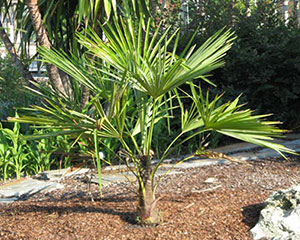 One of the few palms that do better in partial shade, Windmill Palms (Trachycarpus fortunei) are known for trunks bearing a burlap-like fibrous matting.
One of the few palms that do better in partial shade, Windmill Palms (Trachycarpus fortunei) are known for trunks bearing a burlap-like fibrous matting.Planting Site
The Windmill Palm does best when not planted in area that is constantly in full sun (morning/afternoon sun or dappled shade), and it prefers well-drained soils. At maturity, it gets to be 10 to 25 ft. tall by 6-10 ft. wide.
Nutrient requirements
Under the right growing conditions, Windmill Palms typically do not experience significant nutrient deficiencies. Should nutrient deficiencies arise, evidenced by yellowing fronds or yellow/brown spots on fronds, the application of a fertilizer specially formulated for palm is recommended. For more information on palm nutrient requirements click on this link fertilizing palms.
Pests and diseases
As with all other palm species, the fungus Ganoderma zonatum can be an issue for Windmill Palms. Ganoderma symptoms include a large mushroom ‘conk’ at the base of the palm, and drooping fronds. The major pests of Windmill Palms are scale insects and aphids. These pests can go unnoticed until they become a major plant health problem so regularly scouting for signs of pests is recommended.
Learn more:
For more information on the Windmill Palm, click on this link.
Source: UF/IFAS Pest Alert
Note: All images and contents are the property of UF/IFAS.



